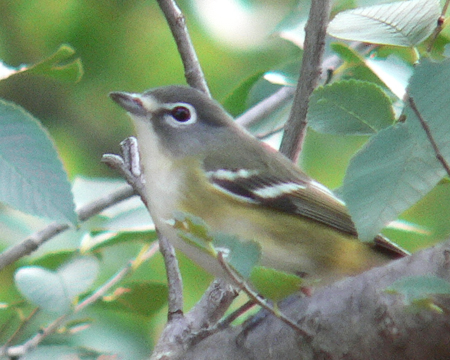By John Shackford

The Solitary Vireo (Vireo solitarius) used to be considered to have several subspecies, including 3 that could be found in Oklahoma. Recently the Solitary Vireo was split into 3 “new” species, the Blue-headed (V. solitarius), Plumbeous (V. plumbeous), and Cassin’s (V. cassinii) vireos. All 3 species can be found in Oklahoma, the latter 2 primarily in Cimarron County, while the Blue-headed Vireo is the one we normally find here in central Oklahoma, and is the most prevalent of the three species found in the state. Of the 3 “new” species, the Blue-headed Vireo is the most colorful, having a greener back and brighter yellow on the flanks than the other two
The Blue-headed Vireo is seen in central Oklahoma only during spring and fall migration. It appears to be the heartiest of the vireos, normally staying later in the fall than other vireos. Because this is such a hearty vireo, it is worth keeping watch for them even into November—the OOS Date Guide gives November 1 as the normal ending date, but quite a number of years ago I saw a “Solitary Vireo”—almost certainly a Blue-headed—at Stinchcomb Refuge in late November or early December. The Blue-headeds even over-winter in McCurtain County, according to the OOS Date Guide. Last year, the Broken Bow, OK, Christmas Bird Count had 2 Blue-headed Vireos, Dallas, TX, had 3, and Little Rock, AR had 4. It winters from the southern U.S. south to El Salvador, but the bird’s winter range, apparently, is moving northward.
We do not have the species as a nester here in Oklahoma and when I wracked my brain for some memory about its nesting, I came up empty—and curious—so I went to bird books and the internet. It usually nests from the southern Appalachian Mountains northward to well into Canada, then across most of southern Canada and a bit into the northern U.S. It normally nests in stands of white pine or hemlock that usually have some hardwood trees mixed in. It builds a typical vireo nest, one that hangs from the fork of a small limb, usually an evergreen limb. The nest is generally 5-20 feet above the ground and normally contains 4 eggs, although nests of 3 and 5 eggs are known. The species behavior at the nest is often so “trusting,” according to Bent (Life Histories of North American Wagtails, Shrikes, Vireos, and their Allies; reprint edition 1965), that one can often touch a bird on the nest. Incubating birds even have been picked off the nest, then place back on, without the bird ever trying to flutter away. Also it has been known to take food from a person’s hand when food is presented to an incubating bird. I feel pretty sure that the Migratory Bird Act now prohibits people from picking vireos (or most anything else) off nests as described above, and I would not suggest doing so in any case. But this is a most interesting vireo behavior observed by earlier naturalists. This vireo is a frequent victim of nest parasitism by Brown-headed Cowbirds, but Breeding Bird Survey data since 1966 indicate that numbers in recent years have increased in most areas.
Of the Blue-headed Vireo, Bent said that “[q]uiet dignity and an air of calm repose seem to dominate its behavior in the security of its woodland home.” This same air, I believe, pertains to migrating Blue-headed Vireos, and can be a refreshing behavioral change, when compared with the more animated behavior of warbler species one often sees nearby.
